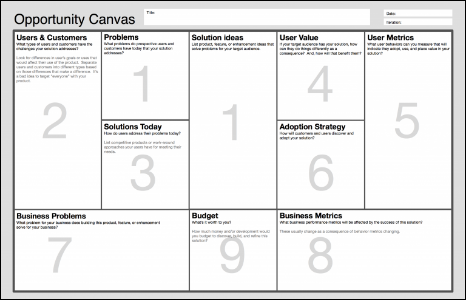Adventures in Opportunity Canvasing, Part 2 of 3
I had convinced my key stakeholder that doing an Opportunity Canvas would be a good way to get started on this new large initiative and was trying to figure out how to pull it off.
Click here to read the first part of this series. This discussion had a lot riding on it, both for this project and future dealings with stakeholders and large initiatives:
- Having this discussion would help us find our best and most impactful opportunity.
- Making sure I add value to users is the reason I do this job, so users are always the reason for doing anything.
- I had been pushing for more collaboration between the teams implementing the solution and the business area. To date, we would just be given a solution to build, that was mandated by someone on the business side, and we would not have much say in execution. This conversation would keep us focused on the problems and opportunities so we could then solve them without a prescription.
- This was brand new functionality that we could run experiments with instead of implementing something no one wanted or would use. This discussion would help identify risks and how to run those experiments.
- Selfishly, this was my first introduction to some stakeholders that I had not yet met, and if I pulled this off, I could come out looking good.
Practice Makes Perfect
With all this at stake, I decided to do a dry run myself. This was new for me. I am a fly by the seat of your pants, figure it out as you go, fake it till you make it type of person. I had tried things like this at previous jobs, without trying them myself first, and they were a struggle. Although people were always willing to try something new, I was not willing to spend time understanding the technique enough to guide them through the first round. I also had a silly notion in my head that if I tried it myself, I would find all the answers, and then the meeting would not feel necessary anymore. I know, I know, bring on the criticism. Reading that now, it is so embarrassing that I had entertained that thought. This time I would do it differently, and I would try it myself first.
I barricaded myself in a little conference room that had a whiteboard with every different color sticky note and marker I could find. I started by drawing out the areas of the canvas and had my first realization – I cannot draw straight lines on a white board, and it takes a while to set the canvas up.
Tip 1: Bring as much pre-assembled, pre-drawn, pre-filled-out materials as you can.
In this case, I decided to fill out the large sticky note paper with the different sections, so I could just reassemble them in the room when I got there. Next, was to start going through each section and using some of the prompt questions from the book to fill them out. Even with the prompt questions, I still had a hard time understanding what should be placed in some of the sections.
Tip 2: Make sure you understand what you are asking your participants to provide or do.
I went back to the Internet to find an example online that would be easy for anyone to understand. Unfortunately I couldn’t find any filled out examples, so I tried to think of easy problems that had already been solved such as adding shopping carts at the grocery store or being able to “like” things on Facebook. If I was asking these questions my first time through you’d better believe others would have the same questions. Had I gone into that meeting with no preparation, I wouldn’t have been able to guide them. Any momentum we had picked up during the conversation would have stalled. By thinking of simpler examples ahead of time, I could relay those stories and help people understand each section.
Now that I had tried a few simpler canvases, I started writing on the whiteboard for my opportunity, only to be repeatedly erasing them and re-writing them elsewhere. I found some should have been in a different section after re-reading it. Occasionally I wanted to create sub-groups within the section to expose a pattern or segment.
Tip 3: Use sticky notes when posting on whiteboards, they are easy to move as the discussion evolves.
After I had finished going through each section, I noticed that I did not like the organization of the Opportunity Canvas as presented by Jeff. As I was talking out loud, reviewing the canvas, I identified a flow that worked better for me. I added a new section for questions and assumptions. I realized much of what I was basing the other sections on were assumptions that should be verified. I also made other sections smaller, because we would not have the right people in the room. The result is this modified template that you can use, and adjust for your needs.
Tip 4: Don’t be afraid to modify methods or practices you get from others to fit your needs.
It is about applying a technique or principle not following it to the letter.
Overall, I was feeling much more confident heading into the meeting. I could facilitate a meaningful discussion, identify what our assumptions were, and we could start experimenting.


